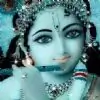Ganesh Chaturthi
It is believed that Lord Ganesh bestows his presence on earth for all his devotees during this festival. It is the day Shiva declared his son Ganesha as superior to all the gods, barring Vishnu, Lakshmi, Shiva and Parvati. Ganesha is widely worshipped as the god of wisdom, prosperity and good fortune and traditionally invoked at the beginning of any new venture or at the start of travel. The festival, also known as Vinayaka Chaturthi("festival of Ganesha") is observed in the Hindu calendar month of Bhaadrapada, starting on the shuklachaturthi (fourth day of the waxing moon period). The date usually falls between 19 August and 20 September. The festival lasts for 10 days, ending on Anant Chaturdashi (fourteenth day of the waxing moon period).
While celebrated all over India, it is most elaborate in Maharashtra, Gujarat, Tamil Nadu, Goa, Andhra Pradesh, Karnataka, Odisha and Chhattisgarh. Outside India, it is celebrated widely in Nepal and by Hindus in the United States, Canada, Mauritius,[1]Singapore, Malaysia, Thailand, Cambodia, Burma, Fiji, Trinidad & Tobago, and Guyana.
Legend
Traditional stories tell that Lord Ganesha was created by goddess Parvathi, consort of Lord Shiva. Parvati created Ganesha out of sandalwood paste that she used for her bath and breathed life into the figure. She then set him to stand guard at her door while she bathed. Lord Shiva returned and, as Ganesha didn't know him, he didn't allow him to enter. Lord Shiva became enraged and asked his follower ghosts to teach the child some manners. Ganesha was very powerful, being born of Parvati, the embodiment of shakti (or power). He defeated the ghost-followers (called "Ghana"s) and declared nobody was allowed to enter while his mother was bathing. The sage of heavens, Narada, along with the Saptarshi (the seven wise rishis) sensed a growing turmoil and went to appease the boy with no results. Angered, the king of Gods, Indra attacked the boy with his entire heavenly army but even they didn't stand a chance. By then, this issue had become a matter of pride for Parvathi and Shiva.
After the devas were defeated, the trinity, the controller, preserver and destroyer of the universe launched an attack against Ganesha. Amidst the fighting, Shiva severed the head of the child. And brought on Parvathi's rage. Seeing her son dead, Parvathi revealed her true self, as the Adi-shakti, the prime energy that fuels the universe and sustains matter. Taking on a terrible form, she vowed to destroy the universe where her son was killed and re-create a better one. The Gods prostrated before her and Shiva promised that her son will live again. The trinity hunted the world for a head and came across a mother elephant crying for her dead baby. They consoled the mother and fixed the head of the baby elephant in place of Ganesha's head. Lord Shiva also declared that from this day, the boy would be called as "Ganesha" (Gana-Isha : lord of the Ganas). In this way, Lord Ganesha came to be depicted as the elephant-headed God.
According to the Linga Purana, Ganesha was created by Lord Shiva and Goddess Parvati at the request of the Devas for being a Vighnakartaa (obstacle-creator) in the path of Rakshasas, and a Vighnahartaa (obstacle-averter) to help the Devas achieve fruits of their hard work.
Ganesh Chaturthi Legends
Legends Of Ganesh Chaturthi
Birth Of Lord Ganesha
One day when Goddess Parvati was taking bath she made a boy from the dough she used for her bath and put life into it. This is how Ganesha was born and she told him to stand on the main doorway of the house. Then, there came Lord Shiva and while going in the house he was stopped on the gate by Ganesha on orders of her mother. Lord Shiva became very angry and cut off Ganesha's head with his trident. When Goddess Parvati came out and saw all this, she, in her anger, asked Lord Shiva to make her son alive or to see her destroying the world. Lord Shiva then went to the earth with Lord Vishnu and took the head of the very first living being to fix it on the body of Ganesha. It was the head of an elephant. After this, Lord Shiva apologised and declared that Lord Ganesha will be worshipped before all the gods and goddesses.
Leader Of The Gods
One day Lord Shiva and other gods decided to choose their leader from Ganesha and Kartikeya, and for this, a race was held between the two brothers. It is said that whoever took seven rounds of the earth first would be made the Ganadhipati or the leader of the gods. The race started and Kartikeya sat on his vehicle, peacock and Ganesha sat on his vehicle, rat. Kartikeya went to complete the seven rounds but then Ganesha realised that it was not easy task for him as his vehicle was a small rat. So, he with his intelligence took seven rounds of his parents, Lord Shiva and Goddess Parvati, and paid obeisance to them. He said that, "my parents pervade the whole universe and going around them is more than going round the earth." All the Gods and Goddesses were surprised to listen the logic of Lord Ganesha and to see his knowledge. Thus, Ganesha completed the race first and came to be popularly known as the Ganadhipati or the leader, which is now referred to as Ganapati.
Ganesha And Single Tusk
This legend is related to the symbolic snake, rat and the single tusk. On one of Lord Ganesha's birthdays, his mother Goddess Parvati prepared 21 types of delicacies and sweet porridge in large amount. He ate so much of it that his big pot-shaped belly could not contain it. He, then on his vehicle, rat, went on his nightly rounds but all of a sudden his mouse stumbled to see a big snake. Lord Ganesha fell down and the entire food came out as his pot-shaped belly burst and then, he put that snake as a belt around his belly. Seeing this, the moon started laughing and this made Lord Ganesha very angry. He then broke off one of his tusks and threw it at the moon. He then cursed the moon that whoever looks at it on the occasion of Ganesh Chaturthi will be accused of doing wrong. It is why looking at the moon on the festival of Ganesh Chaturthi is considered inauspicious.
Gaze of Shani
Other versions
Another tale of Ganesha's birth relates to an incident in which Shiva slew Aditya, the son of a sage. Shiva restored life to the dead boy, but this could not pacify the outraged sage Kashyapa, who was one of the seven great Rishis. Kashyap cursed Shiva and declared that Shiva's son would lose his head. When this happened, the head of Indra's elephant was used to replace it.
Still another tale states that on one occasion, Parvati's used bath-water was thrown into the Ganges, and this water was drunk by the elephant-headed Goddess Malini, who gave birth to a baby with four arms and five elephant heads. The river goddess Ganga claimed him as her son, but Shiva declared him to be Parvati's son, reduced his five heads to one and enthroned him as the controller of obstacles (Vignesha).
Ganesh and the River Kaveri In order to supply water to the arid southern regions, the Sage Agastya, with the blessings of Brahma, got from Shiva a few sacred water which filled his kamandalu . He journeyed to southern regions of the country, hoping to find a suitable place to create a high flow river. Thus he reached the Kodagu (Coorg) mountains. On the way, he hailed a young boy who was passing by. In fact, the boy was Ganesh disguised. The Sage requested the boy to carry carefully his water pot, because he wanted to find an isolated toilet place. Ganesh was aware that Agastya expected to create a river; the place where they were seemed to be favorable. So, he put the kamandalu on the ground. A crow, passing by, landed on the pot edge. When he came back, Agastya expelled the bird which, taking off, spilled the kamandalu. When it poured, this small quantity of water became the Kaveri river. The place, still considered as a sacred one, is known as Talakaveri. |
Kubera's pride takes a fall
We should never take undue pride in our material or spiritual accomplishments. The old saying "Pride always leads to a fall." is proved true in the following story.
Kubera (the God of wealth) invited Shiva and Parvati to dinner wishing to show off his riches. But, the couple denied Kubera's request and said that he could feed Ganesha instead. Kubera laughed and said 'I can feed thousands of children like this."
Ganesha went to his palace and sat down to eat. He started eating all the food placed in front of him. As was the custom, more and more food was served to him, as he did not say that he had enough. Soon there was no more food in the palace and so Kubera ordered his troops to get more food from the surrounding villages. But Ganesha continued eating and there was no more food to be found. Still very hungry, Ganesha started eating all the furniture.
Kubera became very frightened. Ganesha told him, " You promised my parents you will feed me. Now, I have to eat you up as I am still very hungry ". Kubera ran away and pleaded with Shiva to save him from Ganesha. Shiva asked Kubera to give up his pride and serve Ganesha a handful of rice. Kubera went back to his palace. By this time, Ganesha's stomach had become very huge but the child was still hungry. When Kubera served a cup of rice with humility, Ganesha's hunger was satisfied.
Legend has it that the ghat region of Tamil Nadu was ruled by Nambirajan, the king of the Kuravas or the hill tribes. Nambirajan worshipped Shiva, praying for a daughter. His prayers were answered and it was revealed to him that he would discover a baby in the nearby woods and that she would be his daughter.
Accordingly the Kurava king discovered Vallinayaki' in the woods and brought her up as his own. Valli grew up to be a beautiful maiden and Subramanya - son of Shiva and Parvati sought her hand in marriage. Their courtship is full of many interesting stories that form the basis of many a folk tale and classical performing arts in Tamil Nadu.
Murugan assumed the form of an old bangle seller, and sold bangles to Valli, in return for a local delicacy of honey soaked corn flour. A conversation ensued between the two, which was interrupted by the arrival of Valli's brothers, a valiant lot who were highly possessive and protective of their sister. Flustered by their sudden appearance, and unwilling to indulge in battle, Murugan (Skanda) changed himself into a Vengai maram (a stump of which is still seen in the Temple at Velimalai in Southern Tamil Nadu).
Skanda appeared again, in the guise of an old tribal king and sought her hand in marriage. The brothers materialized again, and Skanda transformed himself into an old ascetic from the Himalayas, and they left the spot.
Upset by the ongoing hindrance, Skanda sought the help of his brother Vinayaka - the remover of obstacles, who appeared on the spot as a wild elephant. A scared Valli embraced Skanda and promised to offer him anything in return for protection from the wild beast. Skanda sought her hand in marriage, and Valli consented gladly, realizing that her suitor was none other than Murugan, whom she and her tribe held in great regard.
Valli married Murugan and the marriage was celebrated with great pomp and splendor by Nambirajan, the king of kuravas.
There was a demon (asura) called Gajasura who had all the characteristics of an elephant. He went into penance to please Lord Shiva and became successful in doing so. When Lord Shiva asked his wish, the demon said that he could emanate fire from his body continuously so that no one can come close to him. Lord Shiva granted his wish then again he continued his penance and again Lord Shiva came and asked his wish. This time the demon said, "I desire that you inhabit my stomach." This wish was also granted by Lord Shiva and he resided in the stomach of the demon. Later, when Goddess Parvati could not find her husband, Lord Shiva, she asked Lord Vishnu to find him instead. Lord Vishnu knew everything and this why he reassured her and said, "Don't worry, dear sister, your husband is Bhola Shankara and promptly grants to his devotees whatever they ask of him, without regard for the consequences; for this reason, I think he has put himself into some trouble. I will find out what has happened." Then, Lord Vishnu changed Nandi (the bull of Shiva) into a dancing bull and conducted him before Gajasura and changed himself into a flutist. The pleasing performance of the bull sent the demon into ecstasies and he got impressed. He then asked the flutist his demand, then Lord Vishnu as the flutist said that whatever he will ask for whether the demon will give or not. Gajasura told yes and then the flutist asked to take out Lord Shiva from his stomach. The demon quickly understood that the flutist was no other than Lord Vishnu. He freed Lord Shiva and asked for his last gift and said, "I have been blessed by you with many gifts; my last request is that everyone remembers me adoring my head when I am dead." To fulfil this last wish of Gajasura, Lord Shiva brought his son at that place and replaced his head with that of Gajasura.
The trunk is the elephant's nose and most powerful tool. Man too, according to Hindu philosophy, by learning how to control his breath through yoga, progresses towards actualizing his spiritual powers. The flexibility of the trunk symbolizes the need to be adaptable to circumstances.
The elephant god has those large ears to listen to our numerous pleas for help! They also serve to remind us to be keen listeners. The small eyes tell us to stay concentrated on the task at hand, while the invisible mouth says that excessive speech should be avoided.
Ganesha is called as Vinayaka and Ganapathy. Ganesha is the remover of all obstacles in our inner and outer worlds which arise only due to the fantasies that block the mooladhara charka. Archana and homa for Ganesha, the deity for mooladhara charka when done in the presence of the Master in the energy field effectively energizes the mooladhara charka and removes the root cause of all obstacles in life.
Another most popular legend found in Skanda Purana relates that once Ganesha was invited for a feast in Chandralok. The god stuffed himself with laddoos. When he got up to walk after the meal, he could not balance because of his huge stomach and stumbled. As he fell, his stomach burst and all the laddoos came rolling out. The moon could not contain himself and began laughing. Enraged, Ganesha cursed the moon, causing him to vanish from the universe. However, because of the moon's absence, the whole world began to wane. So the gods asked Shiva to persuade Ganesha to relent. The moon also apologized for his misbehavior. On Shiva's intervention, Ganesha modified his curse. He announced that the moon would be invisible on only one day of a month.
Ganesha in the Vedas
vakratuNDa mahAkAya sUryakoTisamaprabha
nirvighnaM kuru me deva sarvakAryeshhu sarvadA ||
O Ganapati, One with a curved trunk, a large body, and a brilliance equal to a crore (10 million) suns! O God, please make all my undertakings free from obstacles always.
Meaning of the story of Ganesh
At first glance, this story just seems like a nice tale that we might tell our children, or a myth without any real substance. But, it's true mystical meaning is veiled. It is explained thus:
Parvati is a form of Devi, the Parashakti (Supreme Energy). In the human body She resides in the Muladhara chakra as the Kundalini shakti. It is said that when we purify ourselves, ridding ourselves of the impurities that bind us, then the Lord automatically comes. This is why Shiva, the Supreme Lord, came unannounced as Parvati was bathing.
Nandi, Shiva's bull, who Parvati first sent to guard the door represents the divine temperment. Nandi is so devoted to Shiva that his every thought is directed to Him, and he is able to easily recognize the Lord when He arrives. This shows that the attitude of the spiritual aspirant is what gains access to Devi's (the kundalini shakti's) abode. One must first develop this attitude of the devotee before hoping to become qualified for the highest treasure of spiritual attainment, which Devi alone grants.
After Nandi permitted Shiva to enter, Parvati took the turmeric paste from Her own body, and with it created Ganesha.. Yellow is the color associated with the Muladhara chakra, where the kundalini resides, and Ganesha is the deity who guards this chakra. Devi needed to create Ganesha, who represents the earthbound awareness, as a shield to protect the divine secret from unripe minds. It is when this awareness begins to turn away from things of the world, and toward the Divine, as Nandi had, that the great secret is revealed.
Shiva is the Lord and Supreme Teacher. Ganesha here represents the ego-bound Jiva. When the Lord comes, the Jiva, surrounded as it is with the murky cloud of ego, usually doesn't recognize Him, and maybe even ends up arguing or fighting with Him! Therefore, it is the duty of the Lord, in the form of the Guru, to cut off the head of our ego! So powerful is this ego however, that at first the Guru's instructions may not work, as Shiva's armies failed to subdue Ganesha. It often requires a tougher approach, but, eventually the compassionate Guru, in His wisdom finds a way.
Devi threatened to destroy the whole Creation after learning of Ganesha's demise. This indicates that when the ego thus dies, the liberated Jiva loses interest in its temporary physical vehicle, the body, and begins to merge into the Supreme. The physical world is here represented by Devi. This impermanent and changeable creation is a form of Devi, to which this body belongs; the unchanging Absolute is Shiva, to which belongs the Soul. When the ego dies, the external world, which depends on the ego for its existence, disappears along with it. It is said that if we want to know the secrets of this world, which is a manifestation of Devi, then we must first receive the blessings of Ganesha.
Shiva restoring life to Ganesha, and replacing his head with an elephant's, means that before we can leave the body, the Lord first replaces our small ego with a "big", or universal ego. This doesn't mean that we become more egoistic. On the contrary, we no longer identify with the limited individual self, but rather with the large universal Self. In this way, our life is renewed, becoming one that can truly benefit Creation. It is however only a functional ego, like the one Krishna and Buddha kept. It is like a thin string tying the liberated Consciousness to our world, solely for our benefit.
Ganesha is given dominion over the Ganas, which is a general term denoting all classes of beings, ranging from insects, animals and humans to the subtle and celestial beings. These various beings all contribute to the government of the Creation; everything from natural forces like storms and earthquakes, to the elemental qualities like fire and water, to functioning of the body's organs and processes. If we don't honor the Ganas, then our every action is a form of thievery, as it is unsanctioned. Therefore, instead of propitiating each Gana in order to receive their blessings, we bow to their Lord, Sri Ganesha. By receiving His grace, we receive the grace of all. He removes any potential obstacles and enables our endeavors to succeed.
Such is the greatness of Sri Ganesha! Jai Ganesha!
Celebration, rituals and tradition
In Hinduism[edit source | editbeta]
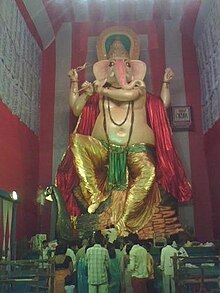 2011 India's Biggest Ganesh Murti (more than 70 feet) inVishakhapatnamGanesh Chaturthi celebrated inVadodara
2011 India's Biggest Ganesh Murti (more than 70 feet) inVishakhapatnamGanesh Chaturthi celebrated inVadodara

Two to three months before Ganesh Chaturthi, artistic clay models of Lord Ganesha are made for sale by specially skilled artisans. They are beautifully decorated and depict Lord Ganesh in vivid poses. The size of these statues may vary from 3/4 of an inch to over 70 feet. The tallest Ganesha Idol made which stood 117 feet tall was situated in the city of Visakhapatnam in 2012.
Ganesh Chaturthi starts with the installation of these Ganesh statues in colorfully decorated homes and specially erected temporary structures mandapas (pandals) in every locality. The pandals are erected by the people or a specific society or locality or group by collecting monetary contributions. The pandals are decorated specially for the festival, either by using decorative items like flower garlands, lights, etc. or are theme based decorations, which depict religious themes or current events.
The priest, usually clad in red or white dhoti and uttariyam (Shawl), then with the chanting of mantras invokes the presence of Ganesha using the statue as a channel, or body for his energy. This ritual is the Pranapratishhtha. After this the ritual called as Shhodashopachara (16 ways of paying tribute) follows. Coconut, jaggery, 21 modakas, 21 durva (trefoil) blades of grass and red flowers are offered. The statue is anointed with red unguent, typically made of kumkumand sandalwood paste. Throughout the ceremony, Vedic hymns from the Rig Veda, the Ganapati Atharva Shirsha Upanishad, and the Ganesha stotra from the Narada Purana are chanted.
Ganesh Visarjan[edit source | editbeta]
Ganesha is worshipped for 10 days from Bhadrapada Shudha Chaturthi to the Ananta Chaturdashi, On the 11th day, the statue is taken through the streets in a procession accompanied with dancing, singing, and fanfare to be immersed in a river or the sea symbolizing a ritual see-off of the Lord in his journey towards his abode in Kailash while taking away with him the misfortunes of his devotees. This is the ritual known as Vinayaga Chathurthi in Tamil, Ganesh Visarjan in Marathi, Ganesha Visarjane in Kannada and Vinayaka Nimarjana or Vinayaka Nimajjanam in Telugu. At individual homes the Visarjan/Nimajjanam is also done on 3rd, 5th or 7th day as per the family tradition. All join in this final procession shouting "Ganapati Bappa Morya, Pudhachya Varshi Laukar ya" (O lord Ganesha, come again early next year) in Maharashtra and "Ganesh Maha Raj ki, Jai" (lord Ganesha, victory is yours) in Andhra Pradesh. After the final offering of coconuts, flowers and camphor is made, people carry the idols to the river to immerse it. Girgaum Chowpatty is one of the famous immersion spot in Mumbai.
Some homes buy their own small clay statue, and after 1,3,5,7 or 11 days immerse it in a bucket or tub at home, so as not to pollute public lakes or rivers. After a few days the clay is used in the home garden.
The main sweet dish during the festival is the modak (modak in Marathi, modakam/kudumu in Telugu, modaka in Kannada and modagam in Tamil). A modak is a dumpling made from rice flour/wheat flour with a stuffing of fresh or dry-grated coconut, jaggery, dry fruits and some other condiments. It is either steam-cooked or fried. Another popular sweet dish is the karanji (karjikai in Kannada) which is similar to the modak in composition and taste but has a semicircular shape.
In Andhra, kudumu (rice flour dumplings stuffed with coconut and jaggery mixture), Vundrallu (steamed coarsely grounded rice flour balls), Panakam (jaggery, black pepper and cardamom flavored drink), Vadapappu (soaked and moong lentils), Chalividi (cooked rice flour and jaggery mixture), etc., are offered to Ganesha along with Modakams. These offerings to god are called Naivedyam in Telugu.
In Andhra, Clay Ganesh (Matti Vinayakudu in Telugu) and Turmeric Ganesh (Siddhi Vinayakudu in Telugu) is usually worshipped at homes along with plaster of paris Ganesha.
Public celebrations of the festival are hugely popular, with local communities (mandalas) vying with each other to put up the biggest statue and the best pandal. The festival is also the time for cultural activities like singing and theater performances, orchestra and community activities like free medical checkup, blood donation camps, charity for the poor, etc.
Today, the Ganesh Festival is not only a popular festival, it has become a very critical and important economic activity for Mumbai, Visakhapatnam,Hyderabad, Bangalore and Chennai. Many artists, industries, and businesses survive on this mega-event. Ganesh Festival also provides a stage for budding artists to present their art to the public. In Maharashtra, not only Hindus but many other religions also participate in the celebration like Muslims, Jains, Christian and others. In Mangalore, there is a belief that the eldest son of the home should be present during pooja.
History
It is not known when and how Ganesh Chaturthi was first celebrated. Ganesh Chaturthi was being celebrated as a public event in Pune since the times of Shivaji (1630-1680), the founder of the Maratha Empire. The Peshwas, the de facto hereditary administrators of the Empire from 1749 till its end in 1818, encouraged the celebrations in their administrative seat Pune as Ganesha was their family deity (Kuladevata). With the fall of the Peshwas, Ganesh Chaturthi lost state patronage and became a private family celebration again till its revival by Indian freedom fighter and social reformer Lokmanya Tilak.[8]
In 1893, Lokmanya Tilak transformed the annual domestic festival into a large, well-organized public event.[9] Tilak recognized the wide appeal of the deity Ganesha as "the god for everybody",[10][11] and popularized Ganesh Chaturthi as a national festival in order "to bridge the gap between Brahmins and 'non-Brahmins' and find a context in which to build a new grassroots unity between them", and generate nationalistic fervour among people in Maharashtra against the British colonial rule.[12][13] Tilak was the first to install large public images of Ganesh in pavilions, and also established the practice of submerging in rivers, sea, or other pools of water all public images of the deity on the tenth day after Ganesh Chaturthi.[14]
Under Tilak's encouragement, the festival facilitated community participation and involvement in the form of intellectual discourses, poetry recitals, performances of plays, musical concerts, and folk dances. It served as a meeting ground for people of all castes and communities in times when, in order to exercise control over the population, the British discouraged social and political gatherings.[15]

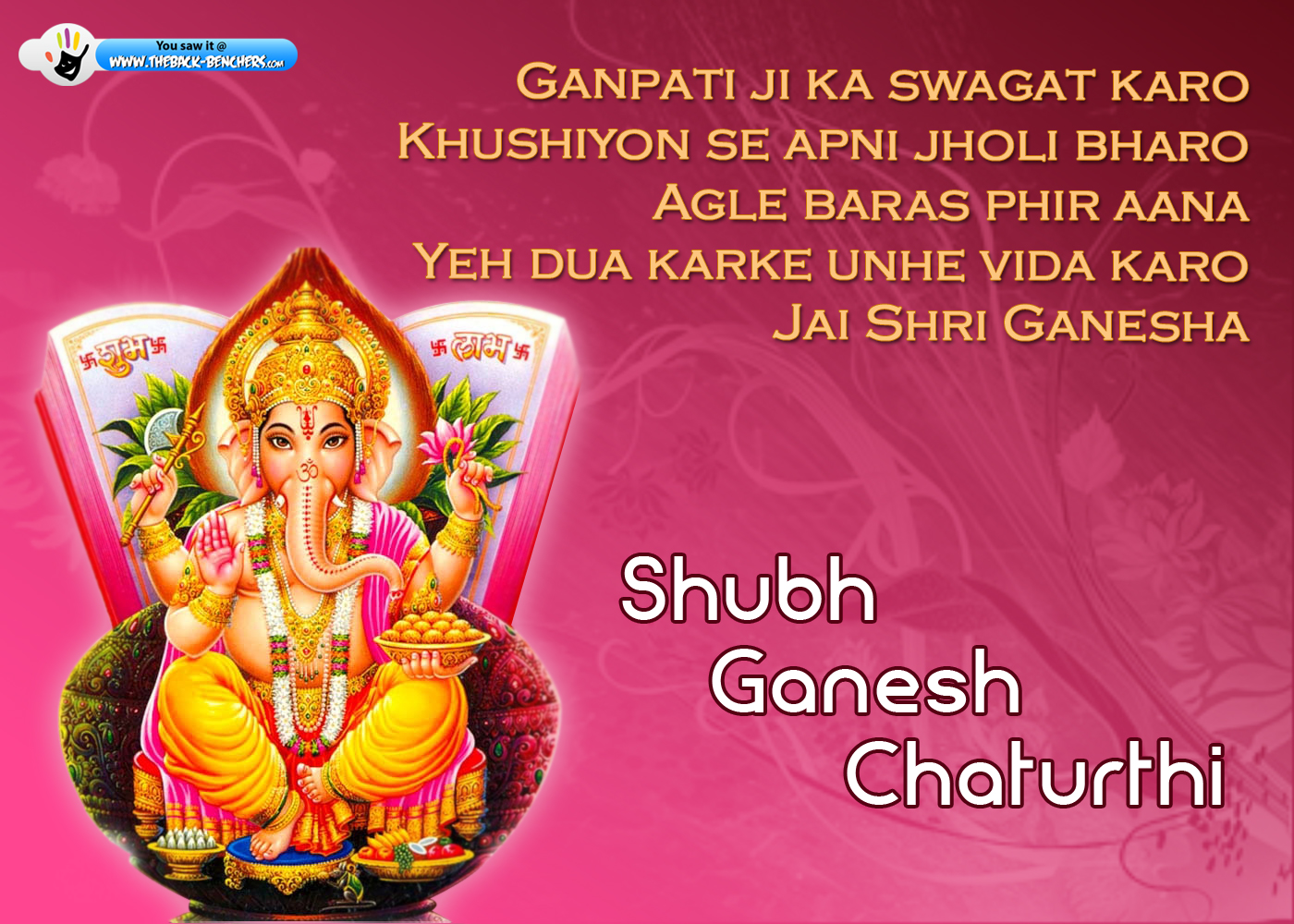
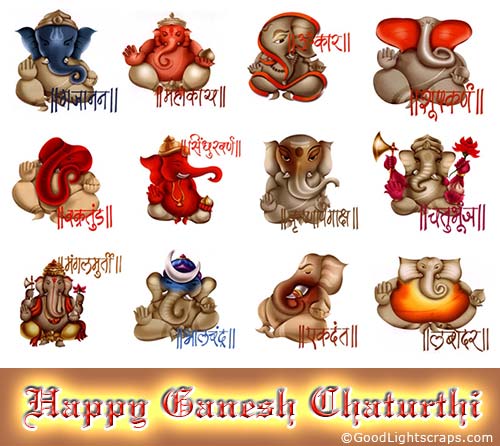

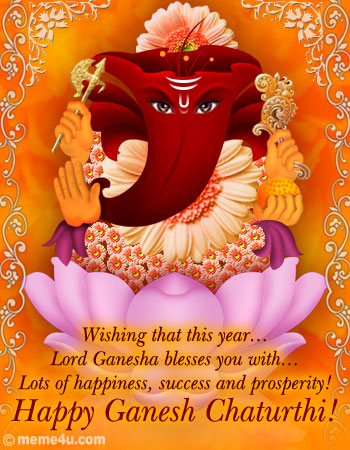
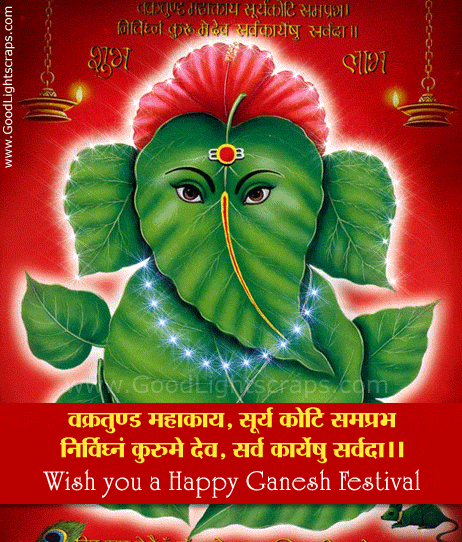
.
SIDDHIVINAYAK MUMBAI
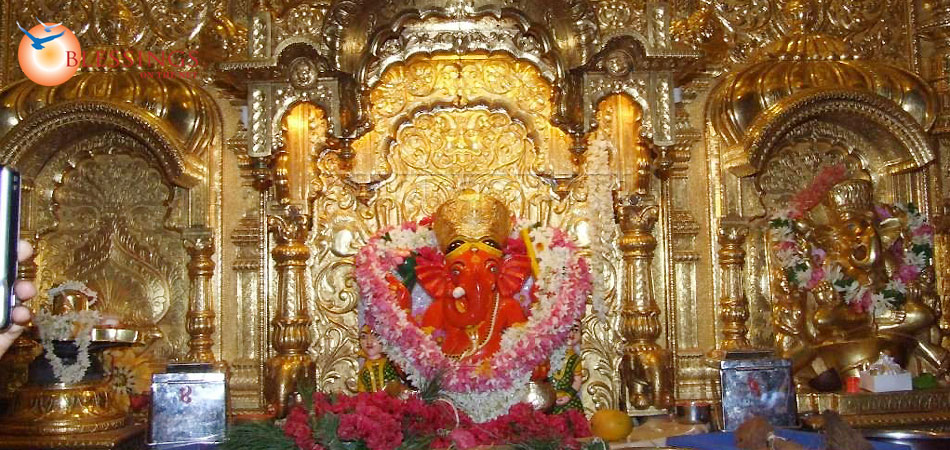
LALBAUGCHA RAJA PUNE

BHOG / PRASAD

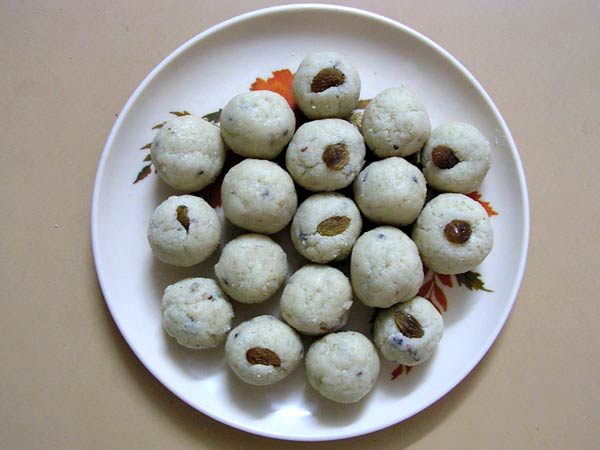
BHAJANS
Jai Ganesh Deva
Jai Ganesh, Jai Ganesh, Jai Ganesh Deva
Mata Jaaki Parvati Pita Mahadeva
Jai Ganesh, Jai Ganesh, Jai Ganesh Deva
Mata Jaaki Parvati Pita Mahadeva
Ek Dant Dayavant, Chaar Bhuja Dhaari
Maathe Pe Sindhoor Sohe, Muse Ki Savari
Paan Chadhe, Phul Chadhe, Aur Chadhe Meva
Ladduan Ka Bhog Lage, Sant Kare Seva
Jai Ganesh, Jai Ganesh, Jai Ganesh Deva
Mata Jaaki Parvati Pita Mahadeva
Andhan Ko Aankh Det, Kodhin Ko Kaaya
Baanjhan Ko Putra Det, Nirdhan Ko Maaya
Surya Shaam Sharan Aye, Safalki Je Seva
Mata Jaaki Parvati Pita Mahadeva
Jai Ganesh, Jai Ganesh, Jai Ganesh Deva
Mata Jaaki Parvati, Pita Mahadeva
Lyrics of Jai Dev Jai Dev
Shendur Laal Chadhaayo Achchhaa Gajamukha Ko
Dondil Laal Biraaje Sut Gauriihar Ko
Haath Liye Guda Ladduu Saanii Sukhar Ko
Mahimaa Kahe Na Jaay Laagat Huun Pad Ko Jai Dev Jai Dev
Jai Jai Jai Jai Jai
Jai Jai Jii Ganaraaj Vidyaasukhadaataa
Dhany Tumhaaro Darshan Meraa Mat Ramataa Jai Dev Jai Dev
Jai Jai Jai ...
Bhaavabhagat Se Koii SharaNaagat Aave
Santati Sampatti Sabahii Bharapuur Paave
Aise Tum Mahaaraaj Moko Ati Bhaave
Gosaaviinandan Nishidin Gun Gaave Jai Dev Jai Dev
Jai Jai Jai ...
Ghaalin Lotaangan Vandiin Charan Dolyaannii Paahin Ruup Tujhe
Preme Aalingin Aananden Puujin Bhaaven Ovaalin MhaNe Naamaa
Tamev Maataa Pitaa Tamev Tamev Bandhushch Sakhaa Tvamev
Tamev Vidyaa DraviNm Tamev Tamev Sarvam Mam Dev Dev
Kaayen Vaach Manasendriyairvaa Buddhyaatmanaa Vaa Prakritisvabhaavaa
Karomi Yadyat Sakalam Parasmai NaaraayaNaayeti Samarpayaami
Achyut Keshavm Raamanaaraayanam Krishna Daamodaram Vaasudevam Hari
Shriidharam Maadhavam Gopikaavallabham Jaanakiinaayakam Raamachandram Bhaje
Hare Raam Hare Raam Raam Raam Hare Hare
Hare Krishna Hare Krishna Krishna Krishna Krishna Hare Hare
[YOUTUBE]https://www.youtube.com/watch?v=Qg88CknV1zY[/YOUTUBE]
[YOUTUBE]https://www.youtube.com/watch?v=WPGgG0OkUIo [/YOUTUBE]
GANESHA IN BAL AVATARS



